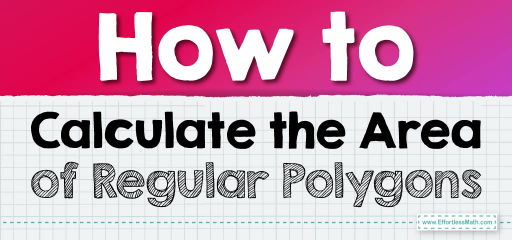How to Calculate the Area of Regular Polygons

- Regular Triangle (Equilateral): Area \(A = \frac{\sqrt{3}}{4} \times \text{side}^2\)
- Regular Quadrilateral (Square): Area \(A = \text{side}^2\)
- Regular Pentagon: Area \(A = \frac{5}{4} \times \frac{\text{side}^2}{\tan(\frac{180}{5})}\)
- Regular Hexagon: Area \(A = \frac{3\sqrt{3}}{2} \times \text{side}^2\)
Examples
Practice Questions:
- Find the area of an equilateral triangle with a side length of \(9 \text{ cm}\).
- What is the area of a square with a side of \(10 \text{ cm}\)?
- Determine the area of a regular hexagon with each side measuring \(5 \text{ cm}\).
- For a regular triangle (equilateral) with a side length of \(9 \text{ cm}\) and an apothem of \(7.79 \text{ cm}\), calculate its area.
- What is the area of a square with a side of \(10 \text{ cm}\) and an apothem of \(7.07 \text{ cm}\)?
- Determine the area of a regular pentagon with each side measuring \(11 \text{ cm}\) and an apothem of \(9 \text{ cm}\).
- \( 35.07 \text{ cm}^2 \)
- \( 100 \text{ cm}^2 \)
- \( 64.95 \text{ cm}^2 \)
- \( 105.21 \text{ cm}^2 \)
- \( 141.4 \text{ cm}^2 \)
- \( 247.5 \text{ cm}^2 \)
Original price was: $109.99.$54.99Current price is: $54.99.
Original price was: $109.99.$54.99Current price is: $54.99.
Original price was: $114.99.$54.99Current price is: $54.99.
Related to This Article
More math articles
- How to Find Patterns of Equivalent Fractions?
- Decimals Unfolded: How to Switch Between Standard and Expanded Forms
- How to Use Grids to Multiply One-digit Numbers By Teen Numbers
- 8th Grade M-STEP Math Worksheets: FREE & Printable
- The Ultimate ATI TEAS 7 Math Formula Cheat Sheet
- Back to School Essentials: Why “Pre-Algebra for Beginners” Should Be on Your List
- Top 10 SSAT Upper Level Prep Books (Our 2023 Favorite Picks)
- How to Navigate Inequalities: The Impact of Addition and Subtraction on Fractional Values
- How to Motivating Disengaged Learners to Enjoy Learning Math
- FREE 7th Grade MEAP Math Practice Test




























What people say about "How to Calculate the Area of Regular Polygons - Effortless Math: We Help Students Learn to LOVE Mathematics"?
No one replied yet.